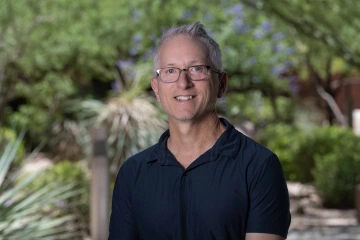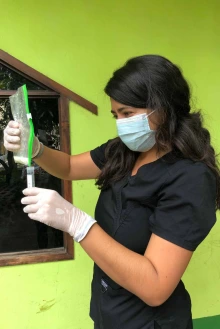Toxic metals linked to impaired growth in infants in Guatemala
The results of a new study could lead to novel approaches for limiting childbirth-related environmental risks.

New research links infant stunting to toxic metals and metalloids found in the breast milk of mothers. The findings could lead to new approaches to improve infant health in Guatemala and around the world.
Photo by MNPhotoStudios via Getty Images
Top takeaways:
- University of Arizona public health researchers showed that arsenic, lead and other metals in breast milk are associated with poor growth in infants.
- Breast milk, a vital form of nutrition for infants, may carry harmful contaminants from polluted environments, including contaminated water that may expose mothers and infants to dangerous metals through breastfeeding.
- Pollution may be an overlooked factor in global child health, according to a new study from the University of Arizona Zuckerman College of Public Health. Environmental action could help protect maternal and child health in vulnerable communities.
Research led by the University of Arizona Health Sciences found a potential link between growth problems among infants and high levels of toxic metals and other elements in the breast milk of Mayan women in Guatemala’s Lake Atitlán watershed region. The findings were reported in the journal Environmental Pollution.

Frank von Hippel, PhD, is a professor of environmental health sciences at the U of A Mel and Enid Zuckerman College of Public Health.
Photo by Noelle Haro-Gomez, U of A Health Sciences Office of Communications
Guatemala has the highest rate of impaired growth, or stunting, in the Western Hemisphere. Stunting is frequently attributed to poor nutrition and infections. Many studies have linked high levels of metals in drinking water to developmental, neurological, and learning problems in young children, but this is the first study to demonstrate an association with stunting in the Americas. The new research results could contribute to a better understanding of the health impacts of such exposures and lead to new approaches for prevention in Guatemala and other countries around the world.
“Detecting toxic metals in breast milk among rural Guatemalan mothers is deeply concerning and highlights the potential role of environmental pollution in undermining child development,” said Sandra Rodríguez Quintana, MD, MPH, a postdoctoral research associate in the U of A Mel and Enid Zuckerman College of Public Health. “Our work calls for interventions to protect maternal and child health and understand how environmental concentrations of metals may be contributing to stunting and other health issues.”
Rodríguez Quintana has been working with communities in the Lake Atitlán watershed since 2022. Rodríguez Quintana and senior author Frank von Hippel, PhD, a professor of public health and director of the One Health program, wanted to look beyond malnutrition and poor health to ask about possible influences of environmental contaminants on children’s growth.

Sandra Rodríguez Quintana, MD, MPH, a postdoctoral research associate in the Zuckerman College of Public Health, collects a sample of breast milk during a trip to Guatemala.
Photo courtesy of Sandra Rodríguez Quintana
The research team studied 80 mothers and their infants from four different Lake Atitlán communities: San Juan La Laguna, San Pedro La Laguna, Panajachel and Santiago Atitlán. The scientists analyzed breast milk samples from the mothers and measured the infants’ lengths.
They detected concentrations of arsenic and lead that exceeded World Health Organization safety standards in breast milk in mothers from Panajachel and Santiago Atitlán.
Additionally, they found that higher breast milk concentrations of arsenic, barium, beryllium and lead were associated with impaired growth of infants in these communities.
Breast milk is the best source of nutrition for infants under six months of age. It also can be a potential route of exposure to toxic metals and other contaminants that may impair neurological development and immune function.
The researchers also examined the levels of toxic metals and metalloids in drinking water samples in each area. They found higher concentrations of arsenic and barium in Panajachel and Santiago Atitlán than in other areas, indicating that drinking water may be an important source of exposure to toxic elements.
“We are working with colleagues in Guatemala to develop interventions that protect maternal and child health,” von Hippel said. “Drinking water contaminated with toxic elements such as arsenic and pathogenic microbes imposes a serious burden on public health, especially for the developing child.”
Additional U of A co-authors include Paloma Beamer, PhD, a professor of public health, associate dean of community engagement and member of the BIO5 Institute; Dean Billheimer, PhD, a professor of public health and director of statistical consulting; Sam Sneed, MPH, senior coordinator of clinical research; and BIO5 Institute statistician Maria Sans-Fuentes, PhD.
The work was supported in part by the National Institute of Environmental Health Sciences, a division of the National Institutes of Health, under award no. P30ES006694.
Experts
Sandra Rodríguez Quintana, MD, MPH
Postdoctoral Research Associate, Department of Community, Environment and Policy, Zuckerman College of Public Health
Frank von Hippel, PhD
Professor, Department of Environmental Health Sciences, Zuckerman College of Public Health
Professor, Clinical Translational Sciences, School of Health Professions, Zuckerman College of Public Health
Director, One Health Research Initiative
Contact
Steve Benowitz
U of A Health Sciences Office of Communications
240-855-1535, sbenowitz@arizona.edu

